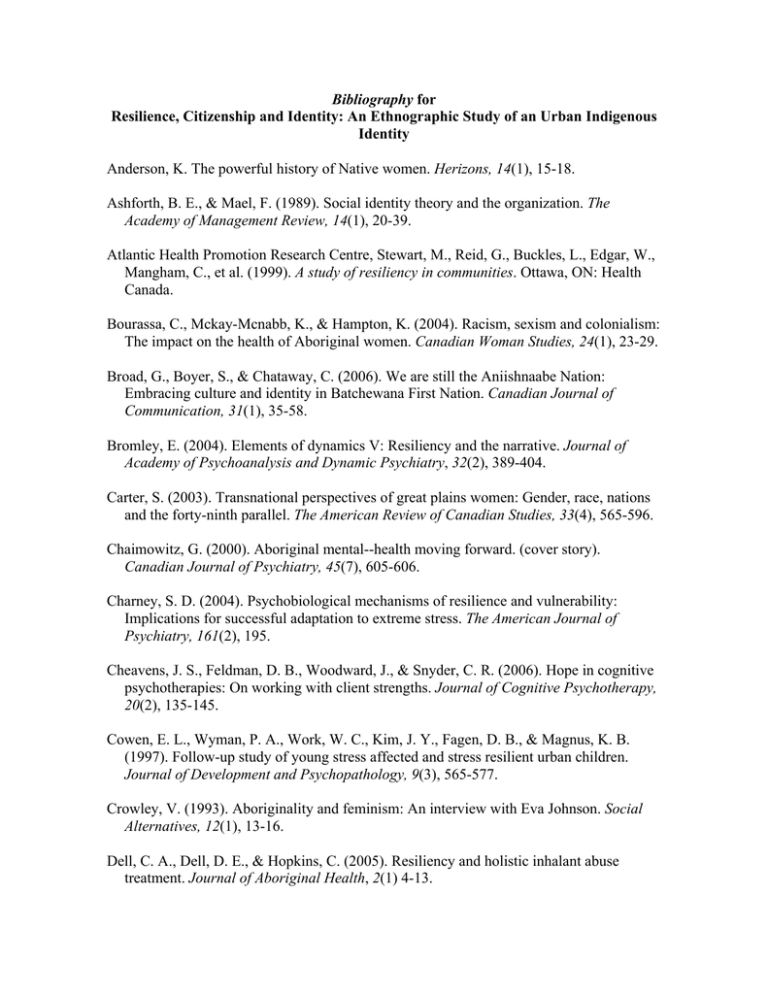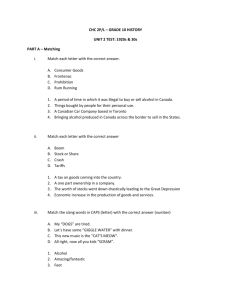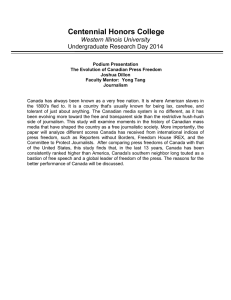Bibliography Resilience, Citizenship and Identity: An Ethnographic Study of an Urban... Identity
advertisement

Bibliography for Resilience, Citizenship and Identity: An Ethnographic Study of an Urban Indigenous Identity Anderson, K. The powerful history of Native women. Herizons, 14(1), 15-18. Ashforth, B. E., & Mael, F. (1989). Social identity theory and the organization. The Academy of Management Review, 14(1), 20-39. Atlantic Health Promotion Research Centre, Stewart, M., Reid, G., Buckles, L., Edgar, W., Mangham, C., et al. (1999). A study of resiliency in communities. Ottawa, ON: Health Canada. Bourassa, C., Mckay-Mcnabb, K., & Hampton, K. (2004). Racism, sexism and colonialism: The impact on the health of Aboriginal women. Canadian Woman Studies, 24(1), 23-29. Broad, G., Boyer, S., & Chataway, C. (2006). We are still the Aniishnaabe Nation: Embracing culture and identity in Batchewana First Nation. Canadian Journal of Communication, 31(1), 35-58. Bromley, E. (2004). Elements of dynamics V: Resiliency and the narrative. Journal of Academy of Psychoanalysis and Dynamic Psychiatry, 32(2), 389-404. Carter, S. (2003). Transnational perspectives of great plains women: Gender, race, nations and the forty-ninth parallel. The American Review of Canadian Studies, 33(4), 565-596. Chaimowitz, G. (2000). Aboriginal mental--health moving forward. (cover story). Canadian Journal of Psychiatry, 45(7), 605-606. Charney, S. D. (2004). Psychobiological mechanisms of resilience and vulnerability: Implications for successful adaptation to extreme stress. The American Journal of Psychiatry, 161(2), 195. Cheavens, J. S., Feldman, D. B., Woodward, J., & Snyder, C. R. (2006). Hope in cognitive psychotherapies: On working with client strengths. Journal of Cognitive Psychotherapy, 20(2), 135-145. Cowen, E. L., Wyman, P. A., Work, W. C., Kim, J. Y., Fagen, D. B., & Magnus, K. B. (1997). Follow-up study of young stress affected and stress resilient urban children. Journal of Development and Psychopathology, 9(3), 565-577. Crowley, V. (1993). Aboriginality and feminism: An interview with Eva Johnson. Social Alternatives, 12(1), 13-16. Dell, C. A., Dell, D. E., & Hopkins, C. (2005). Resiliency and holistic inhalant abuse treatment. Journal of Aboriginal Health, 2(1) 4-13. Dick, C. (2006). The politics of intragroup difference: First nations’ women and the sawridge dispute. Canadian Journal of Political Science, 39(1), 97-116. Dr. Michael Ungar and Research Team. (2006). The resilience project. Retrieved JulySeptember 2006, from www.resilienceproject.org Emberley, V. J. (2001). The bourgeois family, Aboriginal women, and colonial governance in Canada: A study in feminist historical and cultural materialism. Signs, 27(1), 59-85. Floyd, C. (1996). Achieving despite the odds: A study of resiliency among a group of African American high school seniors. The Journal of Negro Education, 65(2), 181-189. Frideres, J.S. & Gadacz, R.R. (2001). Aboriginal peoples in Canada: Contemporary conflicts (Sixth Edition ed., pp. 143). Toronto, ON: Prentice-Hall. Gupta, A., & Ferguson, J. (1992). Beyond "culture":Space, identity, and the politics of difference. Cultural Anthropology, 7(1), 6-23. Hyman, B. & Williams, L. (2001). Resilience among women survivors of child sexual abuse. AFFILIA, 16(2), 198-219. Klohnen, E. C. (1996). Conceptual analysis and measurement of the construct of egoresiliency. Journal of Personality and Social Psychology, 70(5), 1067-1079. Lam, J.N. & Grossman F.K. (1997). Resiliency and adult adaptation in women with and without self-reported histories of childhood sexual abuse. Journal of Traumatic Stress, 10(2), 175. Lawrence, B. (2004). Real Indians and others: Mixed- blood urban Native peoples and Indigenous nationhood. (1st ed.). Vancouver, BC: University of British Columbia. Leipert, B. D., & Reutter, L. (2005). Developing resilience: How women maintain their health in northern geographically isolated settings. Qualitative Health Research, 15(1), 49-65. McKay, S., & Thomas Prokop, S. (2007). Identity, community and resilience: The transmission of values projects. Toronto, ON: Centre of Excellence for Child Welfare. McLeod, B. (2004). First Nations women and sustainability on the Canadian prairies. Canadian Woman Studies, 23(1), 47. Mignone, J. (2003). Measuring social capital: A guide for first nation communities. Ottawa, ON: Canadian Institute for Health Information. Olofsson, E. (2004). In search of a fulfilling identity in a modern world: Narratives of Indigenous identities in Canada and Sweden (1st ed., ). Uppsala University: Department of Cultural Anthropology and Ethnology. Osborne, B. S. (2006). From Native pines to diasporic geese: Placing culture, setting our sites, locating identity in a transnational Canada. Canadian Journal of Communication, 31(1), 147-175. Pengilly, J. W., & Dowd, E. T. (2000). Hardiness and social support as moderators of stress. Journal of Clinical Psychology, 56(6), 813-820. Ramos, H. (2006). What causes Aboriginal protest? Examining resources, opportunities and identity, 1951-2000. Canadian Journal of Sociology, 31(2), 211-234. Richardson, E. G. (2002). Metatheory of resilience and resiliency. Journal of Clinical Psychology, 58(3), 307-321. Sebescen, R. M. (2000). Overcoming the odds: Resiliency in First Nations. Master’s Thesis, University of Manitoba, Winnipeg, Manitoba, Canada. Status of Women Canada. (2000). Aboriginal women's roundtable on gender inequality: Roundtable report. Ottawa, ON: Health Canada. Stout, M. D., Kipling, G., & Stout, R. (2001). Aboriginal women's health research synthesis project, final report. Winnipeg, MB: Canadian Women’s Health Network. Taylor, D. (1997). The quest for collective identity: The plight of disadvantaged ethnic minorities. Canadian Psychology, 38(3), 174. Taylor, D. H. (2000). How Native is Native if You’re Native? In Laliberte, F. R, Settee, P., Waldram B. J., Innes, R., Macdougall, B., & Barron, F. L. (Eds.), Expressions in Canadian Native studies (1st ed., pp. 57). Saskatoon: University of Saskatchewan Extension Press. Waller, M.A., Okamoto, S.K., Miles, B. W., & Hurdle, D. E. (2003). Resiliency factors related to substance use/resistance: Perceptions of Native adolescents of the southwest. Journal of Sociology and Social Welfare, 30(4), 79-94. Walters, K. L., & Simoni, J. M. (2002). Reconceptualizing Native women’s health: An “Indigenist” stress coping model. American Journal of Public Health, 92(4), 520-524. Weaver, N. Hilary, Yellow Horse Brave Heart, Maria. (1999). Examining two facets of American Indian identity: Exposure to other cultures and the influence of historical trauma. Journal of Human Behaviour in the Social Environment, 2(1/2), 19-23. Wolkow, K. E., & Ferguson, H. B. (2001). Community factors in the development of resiliency: Considerations and future directions. Community Mental Health Journal, 37(6), 489-498.






